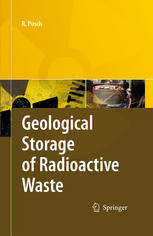
Geological Storage of Highly Radioactive Waste: Current Concepts and Plans for Radioactive Waste Disposal PDF
Preview Geological Storage of Highly Radioactive Waste: Current Concepts and Plans for Radioactive Waste Disposal
Geological Storage of Highly Radioactive Waste Roland Pusch Geological Storage of Highly Radioactive Waste Current Concepts and Plans for Radioactive Waste Disposal 123 Prof.Dr.RolandPusch GeodevelopmentInternationalAB IdeonSciencePark SE-22370Lund Sweden [email protected] ISBN:978-3-540-77332-0 e-ISBN:978-3-540-77333-7 LibraryofCongressControlNumber:2008929595 (cid:2)c 2008Springer-VerlagBerlinHeidelberg Thisworkissubjecttocopyright.Allrightsarereserved,whetherthewholeorpartofthematerialis concerned,specificallytherightsoftranslation,reprinting,reuseofillustrations,recitation,broadcasting, reproductiononmicrofilmorinanyotherway,andstorageindatabanks.Duplicationofthispublication orpartsthereofispermittedonlyundertheprovisionsoftheGermanCopyrightLawofSeptember9, 1965,initscurrentversion,andpermissionforusemustalwaysbeobtainedfromSpringer.Violationsare liabletoprosecutionundertheGermanCopyrightLaw. Theuseofgeneraldescriptivenames,registerednames,trademarks,etc.inthispublicationdoesnotimply, evenintheabsenceofaspecificstatement,thatsuchnamesareexemptfromtherelevantprotectivelaws andregulationsandthereforefreeforgeneraluse. Coverdesign:deblik,Berlin Printedonacid-freepaper 9 8 7 6 5 4 3 2 1 springer.com Preface A major part of this book is based on work performed by several of the national organizations that are responsible for disposal of radioactive waste from nuclear reactors, with the Author involved in the research as well in the reporting. He is greatlyindebtedtotheorganizationsandtotheirrepresentativesthatwereengaged in the projects, and to the European Commission, represented by Mr Christophe Davies,thatsupportedtheworkfinanciallyandotherwise.MrDavies’servicesare gratefullyacknowledged.Theauthoralsoexpresseshisthankstothefollowingper- sons who assisted in various ways in the preparation of the book: Christer Sve- mar,SwedishNuclearFuelandWasteManagementCo(SKB),Sweden;WolfSei- dler,Agence National pour lagestion des Dechets Radioactifs (ANDRA),France; JanVerstricht,StudiecentrumvoorKernenergie-Centred’Etudedel’e´nergieNucle- are(SCK-CEN),Belgium;andTilmannRothfuchs,Gesellschaftfu¨rAnlagen-und ReaktorsicherheitGmbH(GRS),Germany. Lund,January2008 RolandPusch v Acknowledgment The author expresses his thanks to the following persons who assisted in vari- ous ways in the preparation of the book: Christer Svemar, Swedish Nuclear Fuel and Waste Management Co (SKB), Sweden; Wolf Seidler, Agence National pour la gestion des Dechets Radioactifs (ANDRA), France, and Tilmann Rothfuchs, Gesellschaftfu¨rAnlagen-undReaktorsicherheitGmbH(GRS),Germany. vii Contents Introduction ....................................................... 1 NationalandInternationalWork ................................... 1 BasicPrincipleofFinalStorageofHazardousWaste .................. 2 TheCROPProject ............................................... 3 CrystallineRock........................................... 5 SaltRock................................................. 5 ArgillaceousRockandClasticClay........................... 6 TheLowRiskDepositionTechnologyProject ....................... 6 TheESDREDProject ............................................ 9 OptionsforDisposalofHLW...................................... 9 References ..................................................... 11 1 TheGeologicalBaseforDevelopingandAssessingConceptsfor HLWDisposal.................................................. 13 1.1 RockTypesConsideredforHLWDisposal..................... 13 1.1.1 StrainintheShallowEarthCrust....................... 14 1.1.2 ElementsintheEarthCrustthatcanAffectIsolation ofRadionuclidesinHLWRepositories–RockStructure .. 14 1.2 CrystallineandArgillaceousRock ............................ 17 1.2.1 EvolutionofDiscontinuities........................... 17 1.2.2 RegularorRandomStructuralConstitution .............. 20 1.3 SaltRock................................................. 22 1.4 ClasticClay............................................... 24 1.5 TheImportanceofScale .................................... 25 1.5.1 CrystallineRock .................................... 25 1.5.2 SaltandArgillaceousRock,andClasticClay ............ 27 References ..................................................... 28 2 TheRock ...................................................... 29 2.1 WhatisRequired? ......................................... 29 2.2 Structure-ControlledPropertiesofCrystallineandArgillaceous Rock .................................................... 29 2.2.1 General ............................................ 29 ix x Contents 2.2.2 RockStrength ...................................... 30 2.2.3 ScaleDependenceofStrengthandConductivity .......... 31 2.3 Structure-ControlledPropertiesofSaltRock andClasticClay........................................... 40 2.3.1 SaltRock .......................................... 40 2.3.2 ClasticClay ........................................ 40 2.4 WhatRoledoDiscontinuitiesPlayinRepositoryRock?.......... 42 2.4.1 Excavation-InducedDisturbance....................... 42 2.5 TheIntegratedPerformanceofHostRock...................... 57 2.5.1 WhatisImportant? .................................. 57 2.5.2 OverviewofRockIssues ............................. 57 References ..................................................... 70 3 EngineeredBarriersandTheirInteractionwithRock .............. 71 3.1 EngineeredBarriers ........................................ 71 3.2 HLW..................................................... 71 3.3 Canisters ................................................. 74 3.3.1 DesignandMaterial ................................. 74 3.3.2 Physical Performance of the Presently ProposedSKBCanister.............................. 76 3.3.3 TheHIPOWCanister ................................ 82 3.3.4 ChemicalIntegrityofCopperCanisters ................. 83 3.4 Clay ..................................................... 84 3.4.1 TheRoleofClaysinaRepository...................... 84 3.4.2 SmectiteMinerals ................................... 85 3.4.3 MicrostructuralConstitutionofSmectiteClays–AKey Issue.............................................. 88 3.5 Buffer.................................................... 88 3.5.1 Function ........................................... 88 3.5.2 EvolutionoftheBuffer............................... 92 3.5.3 WettingRateoftheBuffer ............................ 93 3.5.4 MechanicalProcessesintheBuffer..................... 98 3.5.5 MaturationofBufferSubmergedinSmectiteMud ........ 99 3.5.6 ModellingofBufferEvolution–ConceptualVersion......102 3.5.7 ModellingofBufferEvolution–The“Codes”............105 3.5.8 Can One Predict with Accuracy Even the Simpliest Process,i.e.WaterSaturation,byUsingtheProposed Codes?............................................ 109 3.5.9 How does the Predicted Buffer Performance Agree withtheRecorded?.................................. 112 3.5.10 HowdoPredictedandRecordedCanisterMovements intheClayAgree? .................................. 117 3.5.11 Long-TermFunctionofBufferClay ....................127 3.5.12 ImpactonBufferandBackfillsofChemicalReactions withOtherBarriers.................................. 144 Contents xi 3.5.13 Other Processes of Importance to the Function ofBufferClay...................................... 154 References .....................................................164 4 RepositoryConceptsforHLWIncludingSpentFuelandWastewith Long-LivedRadionuclides .......................................167 4.1 MajorPrinciplesofStoringHLW.............................167 4.2 RepositoryConcepts .......................................167 4.2.1 TheCompleteRepository.............................167 4.2.2 AlternativeConcepts.................................170 4.3 Canisters,BuffersandBackfills–TheEngineeredBarriers .......171 4.3.1 GeneralPrinciples ...................................171 4.3.2 Canisters...........................................171 4.3.3 Buffers ............................................171 4.3.4 Backfills ...........................................172 4.3.5 Plugs ..............................................172 4.3.6 Grouts.............................................175 4.4 Construction and Performance of Buffers and Backfills inCrystallineRock ........................................ 180 4.4.1 TheKBS-3VConcept ...............................180 4.4.2 KBS-3VTypeConceptswithMoreThanOneCanisters ...191 4.4.3 WideRoomswithArraysofCanisters ..................196 4.4.4 InclinedDepositionHoleswithSingleCanisters..........196 4.4.5 VeryLongHoles(KBS-3H)...........................199 4.4.6 AssessmentoftheConceptsAppliedtoCrystallineRock ..204 4.4.7 The“Optimal”Concept ..............................208 4.5 Construction and Performance of Buffers and Backfills inSaltRock .............................................. 222 4.5.1 General ............................................222 4.5.2 DescriptionofDisposalConcepts ......................222 4.5.3 RequiredFunctionoftheRepository....................226 4.5.4 CurrentRepositoryDesignPrinciples...................227 4.5.5 EngineeredBarrierSystems...........................229 4.5.6 DesignandConstruction..............................231 4.5.7 ConceptualandMathematicalModels ..................233 4.6 Construction and Performance of Buffers and Backfills inArgillaceousRock ....................................... 244 4.6.1 General ............................................244 4.6.2 NationalConcepts ...................................246 4.7 BoreholeSealing...........................................258 4.7.1 TheSKB/POSIVAStudy .............................258 4.7.2 TightSeals .........................................258 4.7.3 The“Container”Concept .............................266 4.7.4 The“Couronne”Concept .............................266 4.7.5 The“Pellet”Concept.................................266 xii Contents 4.8 StabilizationofFractureZonesinBoreholes....................270 4.8.1 Principle ...........................................270 4.8.2 Material ...........................................270 4.8.3 Construction of Concrete Plugs in Stabilized Parts ofBoreholes ....................................... 271 References .....................................................272 5 UndergroundLaboratories(URLs) ...............................275 5.1 NeedsandObjectives.......................................275 5.2 NationalUndergroundLaboratoriesinCrystallineRock..........276 5.2.1 General ............................................276 5.2.2 Stripa(SKB) .......................................276 5.2.3 A¨spo¨ (SKB) ........................................277 5.2.4 Grimsel(NAGRA) ..................................278 5.2.5 Pinawa(AECL) .....................................279 5.2.6 Onkalo(POSIVA) ...................................279 5.3 NationalUndergroundLaboratoriesinSaltRock................280 5.3.1 General ............................................280 5.3.2 BeddedSalt ........................................280 5.3.3 DomalSalt .........................................283 5.4 NationalUndergroundLaboratoriesinArgillaceousRock ........285 5.4.1 General ............................................285 5.4.2 ResearchandDevelopment ...........................286 5.4.3 ActivitiesinURLsinArgillaceousRock ................286 5.5 StudyofRockPropertiesintheURLs .........................288 5.5.1 RockStructure,GeohydrologyandGeochemistry.........288 5.5.2 Stability ...........................................294 5.5.3 EDZ...............................................296 5.6 BufferandBackfill.........................................298 5.6.1 PreparationandManufacturing ........................298 5.6.2 HandlingandPlacement..............................299 5.7 InstrumentationandDataAcquisition .........................302 5.7.1 WhatShallbeMeasured?.............................302 5.7.2 Practicalities........................................303 5.7.3 SelectionofInstruments ..............................304 5.7.4 ARealProblem .....................................304 5.7.5 DataAcquisitionPrinciples ...........................305 5.8 Testing ...................................................306 5.8.1 Principles ..........................................306 5.8.2 Powering...........................................307 5.8.3 The Role of Rock as Supplier of Water for Wetting oftheBuffer ....................................... 308 5.8.4 BufferPerformance..................................308 5.8.5 ConceptualandTheoreticalModels ....................311 5.9 PlugConstruction..........................................313
